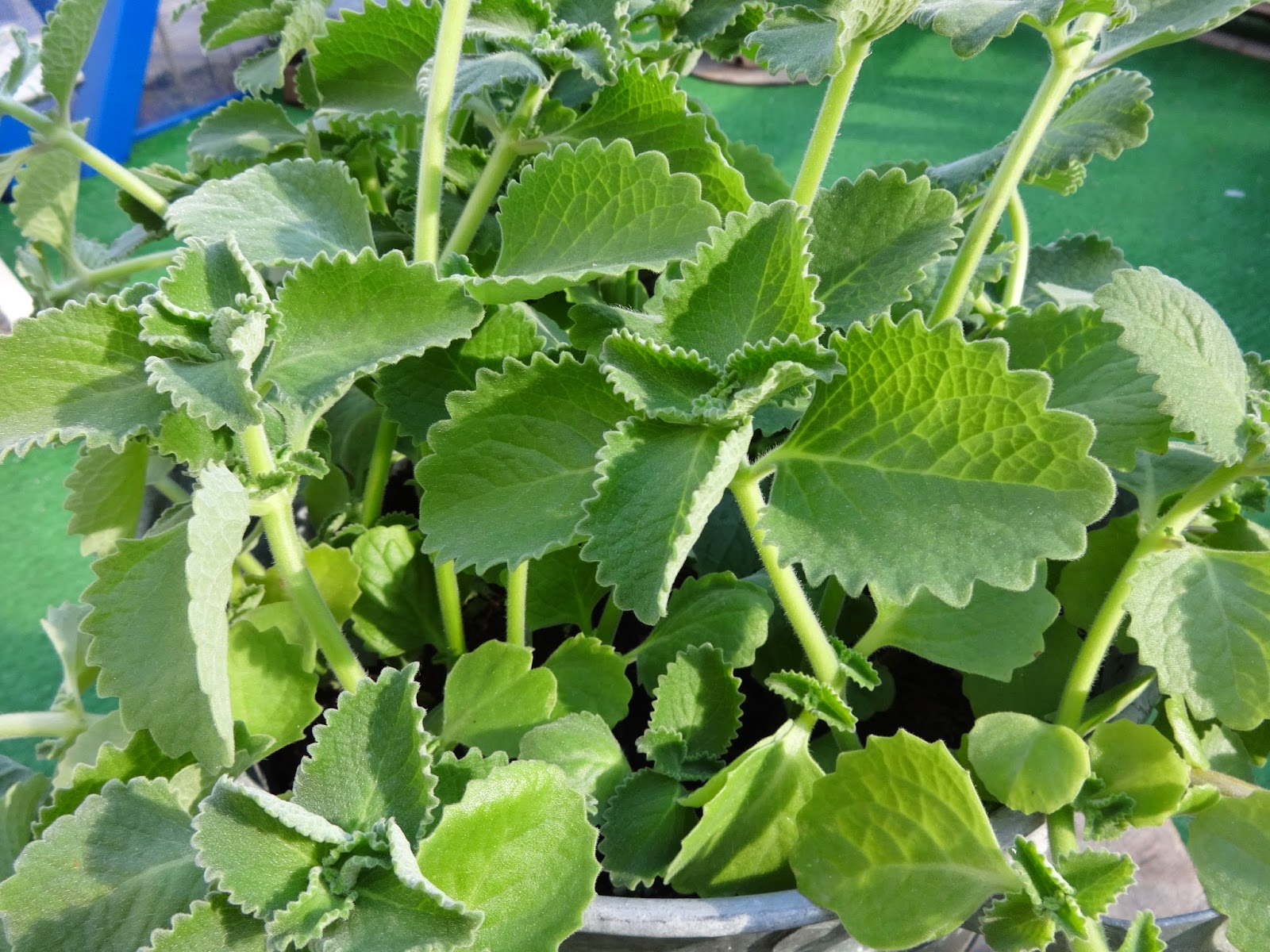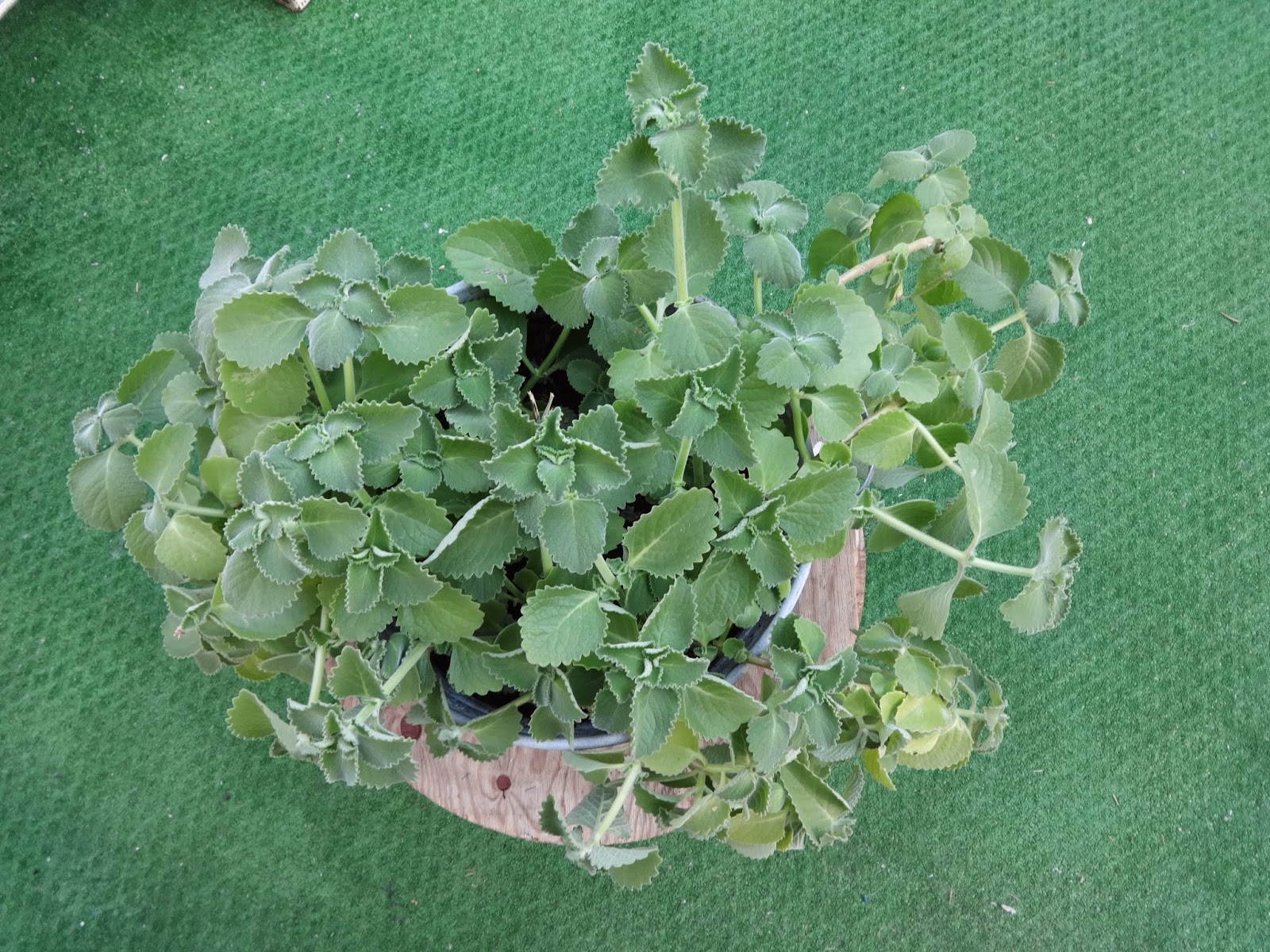PLANT PROFILE
The plant that You can see on photos here is a herb that have many names. Its most popular latin name is Plectranthus amboinicus, but this name is also used commonly, mistakenly for closely related species Plectranthus tomentosa, Plectrantus cremnus and their many hybrids. Other are Coleus aromaticus, Coleus amboinicus, and Plectranthus aromaticus. Most popular english common name seems to be Cuban Oregano, but its also called Mexican Mint, Country Borage, Indian Borage, Big Thyme, Spanish Thyme, Allherb, Queen of herbs and by many other names, all of which are also used for closely related Plectranthus genotypes mentioned above. There is a mess about its origin as well. According to some sources it is native to south-east of Africa, but other claims it to come from south-east Asia. What's certain about this plant, is that it is valuable herb, known in India since ancient sanskrit times and nowadays very popular around whole tropical world. The reason for this is colonial history that helped to spread it to places where it thrive well. European colonists probably quickly found out that their beloved Mediterranean Oregano and Thyme can't cope with tropical weather. And luckily they've found good substitute, as Plectranthus amboinicus contain thymol and carvacrol, chemical compounds responsible for smell and taste of Oreganos and Thymes. In few recent years this earlier unknown herb gained some popularity in northern Europe, and with its easy indoor maintance, pleasant aroma and many health benefits. I think it is just the matter of time when it'll become as popular as Aloe vera.
CULTIVATION AND HARVESTING
Coleus aromaticus is small succulent shrub with tendency for climbing or creeping, it can reach over 1m hight and even more in width. It have strong stems with fleshy, hairy leaves and blue-violet or white-pink flowers in summer time. It grows best in rich, compost soil with neutral pH and high humidity, but if there will be excess of water in the ground its roots might start to rot. On the other hand it cope well with severe droughts, as it have lots of water stored in its succulent flesh. It also cope well with severe heat and scourging sun, as well as with strong shade (except variegata form with white staid green leaves), but feels best in partial shade. For all those reasons, it is very easy to grow indors and that is why it is becoming more and more popular house plant in northern Europe. Cuban oregano can't stand temperatures lower than 0'C and feel bad even when its colder than 10'C. Best way for using it is to pick it fresh, as its leaves and stems contain so much water, that even cuted into small pieces it won't dry well. Besides with good conditions, You can enjoy its fresh, tender, crunchy leaves all year round, so there's no point to gather and storage any for later.
CULINARY USES
Cuban oregano is quite similar in taste to Greek Oregano (Origanum vulgare), so it might be used in the same way. It can be cutted in small pieces and added to salads, sandwiches, soups, meat dishes and many other meals. In India its whole, fresh, crunchy leaves are dipped in batter and fried in deep oil, this snack is called ,,Ajwain ke patta pakoda''. It also can be pickled or mashed into chutney. Squizzed juice or chopped fresh leaves are added to both alcoholic and non-alcoholic drinks for its flavour.
MEDICINAL USES
Coleus aromaticus is still quite unknown among Eastern herbalists, but as the plant is becoming more popular, so is the knowledge about it. There is growing number of researches that are proving its effectiveness in fighting ailments, that it was used for in Asia for centuries. It contain carvacrol, thymol, eugenol, quercetin, apigenin, luteolin, salvigenin, genkwanin caryophyllene, patchoulane and p-cymene. This herb is antioxidant, antimicrobial, antibacterial, antiviral, antifungal, radioprotective, carminative, tonic, stimulant, emmenagogue, hepatoprotective, diaphoretic, antiepileptic and galactagogue.
Cuban oregano leaves are simply eaten fresh for coughs, colds, malarial fevers, asthma, bronhit, mouth and nasal infections, diarrhea, indigestion, flatulence, dyspepsia, epilepsy, rheumatism, kidney stones and helminthiasis. Fresh crushed leaves are applied on burns, sprains, skin infections, scorpio bites or on forehead to ease headache. Decoction from leaves is giving after childbirth and soup with it is given to breastfeeding mothers to support lactation. It is also given to children for colic and colds. For ear aches (otalgia) pure fresh juice is poured into the ear and keep for 10 minutes.



Sources
http://www.stuartxchange.com/Oregano.html
http://www.greenpharmacy.info/article.asp?issn=0973-8258;year=2008;volume=2;issue=3;spage=182;epage=184;aulast=Kaliappan
http://en.wikipedia.org/wiki/Plectranthus_amboinicus
http://www.tarladalal.com/Ajwain-Patta-ke-Pakode-4970r
http://www.sailusfood.com/2010/06/19/vaamu-aaku-bajji-ajwain-patta-fresh-carom-leaves-ke-pakode/
http://www.bawarchi.com/recipe/vamu-aaku-patchadi-ajwain-leaves-chutney-oeswBjedeiadh.html
http://whateverchumps.blogspot.com/2011/07/ajwain-patta-parantha.html
http://www.lifewithspices.com/2011/11/karpuravallicuban-oregano-rasam.html
http://www.ayurveda-florida.com/Ayurvedic_Materia_Medica_Articles/Table2.htm













































Thank you very much for this post. I live in New Zealand & have recently started growing this plant. I wanted to know more about it & found your blog. Great information! Thank you again. Kindest regards, Catherine
ReplyDeleteThank you. I'm glad to know that it is useful.
ReplyDeleteThank you excelent article blessing from Dominican Republic!!
ReplyDeleteThank you for your post. I'm in Costa Rica and have been using this (thinking it was another Oregano) for years! It is more flavorful than organo and is very easy to grow from cuttings. I'm at 5000 ft altitude and the plant grows to 2 meters tall and can cover the yard if not pruned frequently.
ReplyDeleteThank you. I think I am going to try to tincture it as my son would take it in that form and he would certainly refuse to eat the leaves. It grows very well and smells like menthol to me.
ReplyDeleteYes, most of children don't like pungent smell and bitter taste of Cuban Oregano. That is why in the Philippines parents are squeezing juice from it's succulent leaves and soft young stems on spoon full of sugar, and they giving it to swallow to their kids for coughs.
DeleteThat is a great idea, although honey would be healthier than sugar.
DeleteExcellent information - I have been trying to identify this plant correctly and gain some further information on its uses. Thanks for the time it took you to write and share with all of us! Narelle - from the Sunshine Coast area of Queensland - Australia
ReplyDeleteExcellent information...........
ReplyDeleteExcellent information.....ponnobikri
ReplyDeleteInformative. I have been using this herb from the time I knew it as a child. In Barbados we called it broadleaf thyme. We use it also to make seasoning. Interesting plant.
ReplyDeleteWonderful i live in the tropics an it grows here well i use this plant combine with leaf of life...wondetful
ReplyDeleteWonderful plant .use it for coughs and cold and in food seasonings.. mild enough for infant use in the right proportion.
ReplyDeleteThanks.i5 grows iny garden wildly.i use for stews,sources and porridge yam or sweet potatoes.very nice .
ReplyDeleteI have alot of it but now I now how to use it thank you from Kenta Africa
ReplyDeleteAnedy Mutonyi Kenya Africa. Now I know thank you very much. I have a lot of it
ReplyDeleteThank you so much for sharing this informative piece on this herb. Greetings from Nigeria
ReplyDeleteThanks a lot for indepth search for this wonder-herb.Its also found in Kenya,Eastern Africa.Trying to get the common name given to this herb by Kalenjin language.Aloe Vera is in plenty&crucial herb in Kenya.
ReplyDeleteIn Uganda we use it for bathing after a woman gives birth..u boil and it's water for both bathing and drink warm water to clean blood after child birth,also use for bathing a new born baby
ReplyDeleteThank you all for sharing with us here you knowledge and experience.
ReplyDeleteIt's g6 for making tea
ReplyDeleteI has this plant,I uses it in various dishes.
ReplyDeleteIt is very tasty and healthy.
I boiled this plant and took a cup after it cooled - and my excessive bleeding stopped - it’s used for reproductive issues in my country - elders in Africa recommend it for reproductive related challenges
ReplyDeleteThank you for all this information.
ReplyDelete